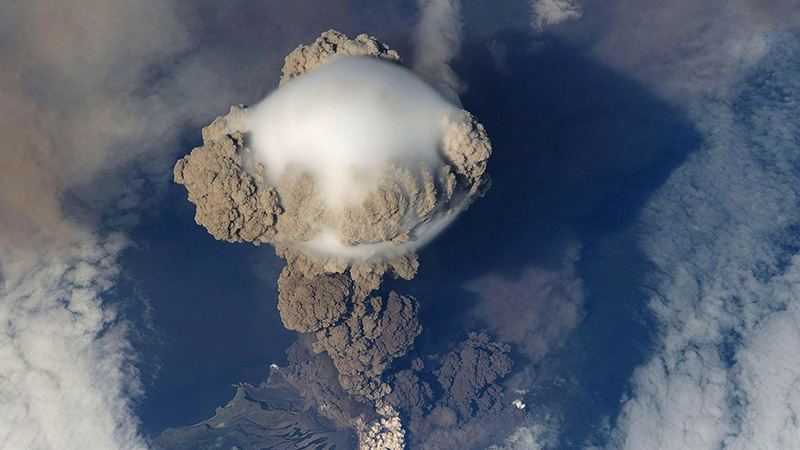Countries should resist the urge to experiment with large scale planetary geoengineering until it’s clear what the consequences of meddling with the oceans or atmosphere may be.
That’s the nub of a decision expected to be taken at the UN’s biannual biodiversity summit taking place in Cancun, Mexico this week, emphasising a “precautionary approach” to such projects.
With greenhouse gas emissions closing in on levels that could guarantee warming of 1.5C above pre industrial levels and an El Nino-boosted 2016 likely to be the hottest year on record, some scientists are looking to emergency measures.
But the UN is sticking to a familiar line: pumping the atmosphere with tiny mirrors to deflect sunlight, boosting the uptake of CO2 in oceans by stimulating plankton growth, or burning wood and pumping the emissions underground could be a bad idea.
Tuesday's version of the UN @CBDNews's plea to countries not to start #climate geoengineering #COP13 pic.twitter.com/AhtymkgKLK
— Ed King (@edking_I) December 7, 2016
“We’re concerned that with any initiative regarding the use of geoengineering there needs to be an assessment,” UN biodiversity chief Braulio Ferreira de Souza Dias told Climate Home.
“These can have unforeseen results and spin-offs. If you capture carbon in the oceans, this is effective through all the food chains.”
Even national risk assessments on individual geoengineering projects would still form an “incomplete basis for global regulation” says the latest iteration of the UN draft decision, echoing previous Convention on Biological Diversity (CBD) decisions in 2010, 2012 and 2014.
“More trans-disciplinary research and sharing of knowledge among appropriate institutions is needed,” it says, citing potential impacts on ecosystems and potential ethical issues.
For instance, one study by scientists at the UK Met Office in 2013 said the release of fine particles into the northern hemisphere atmosphere could lower temperatures, but heighten drought risk in the Sahel.
There’s a secret UN #climate adaptation summit taking place in Mexico https://t.co/QrNuZIyKPE pic.twitter.com/6ZYZpjbskI
— Climate Home News (@ClimateHome) December 7, 2016
Still, Bristol University academic Matt Watson – one of the UK’s top geoengineering researchers – told Climate Home there are still a “range of experiments that would not have any effect on biodiversity”.
“We are not doing a great job of protecting biodiversity now (the IPCC’s projections are truly terrifying) – how will we know if geoengineering would exacerbate (or reduce) impacts on biodiversity unless we research it?” he said in an email.
That view was echoed by Richard Darton, co-director of the Oxford Geoengineering Programme, who said controlled tests allowed under CBD rules should continue “to verify the science and engineering” but that more research was inevitable given the scale of warming
“Whilst I thoroughly agree that we can best cut anthropogenic emissions as the best way to manage climate change, the CBD will have to face the fact that it simply isn’t happening fast enough,” he said.
“Learning more about geoengineering is absolutely necessary. At the moment we have the bizarre circumstance that climate scenarios which will meet 2C assume BECCS [bioenergy with carbon capture and storage] will be applied on a very big scale – an assumption at odds with the resolution of CBD apparently.
“We simply must explore BECCS and all the other techniques to understand what (if anything) they can do for us, and what the entire earth-system and human-system impacts might be.”
Weekly briefing: Sign up for your essential climate politics update
The last publicised large-scale geoengineering trial took place in 2012 when a US businessman dumped tonnes of iron filings into the sea off Canada, in violation of the UN moratorium.
The aim was to suck carbon from the atmosphere by stimulating the growth of plankton which would then die and sink to the ocean floor, thus sequestering the CO2.
In 2013, leaked documents revealed Russia pushed for the UN’s climate science body to support the potential of geoengineering to lower global temperatures in its major AR5 climate report.
In the event the the Intergovernmental Panel on Climate Change (IPCC) study did cover geoengineering, warning of “numerous uncertainties, side effects and risks” of efforts to manage solar radiation.
Since then, information on other programmes has been thin. Germany is conducting indoor experiments while the UK government recently stumped up £8·3 million (US$10.5m) for research into technologies to suck carbon dioxide from the atmosphere.
Policy inertia
The UN CBD draft decision notes “very few countries” have provided “information on measures they have undertaken”.
Poor reporting and the lack of debate around the issue are a concern, said Andrew Light, a former US senior state department climate official and a professor at George Mason University, who interpreted the CBD text as a “plea” rather than a ban.
“If we are ever to have a conversation about governance we need to normalise reporting,” he told Climate Home, suggesting this would be a first step before out-of-laboratory experiments are authorised.
“We need to be looking into the full range of activities, especially when we’re talking about the need to move towards net decarbonisation by 2050 or thereafter.”
“Countries have not provided information because they are not talking about it,” said Janos Pasztor, climate advisor to outgoing UN secretary general Ban Ki-moon and head of the Carnegie Climate Geoengineering Governance Project.
“There is practically no discussion at a policy level – it’s a big gap and we need to shift the debate.”
